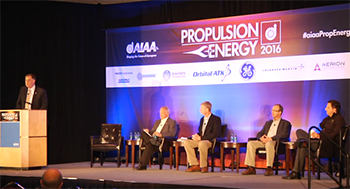Reusable Space Systems Are Obtainable Written 25 July 2016
In This Section

Panelists participate in a discussion on “Launch Vehicle Reusability: Holy Grail, Chasing Our Tail, or Somewhere in Between?” 25 June, at the 2016 AIAA Propulsion and Energy Forum in Salt Lake City.
Panelists: Moderator Dan Dumbacher, professor of engineering practice, Purdue University; Doug Bradley, chief engineer of advance space and launch, Aerojet Rocketdyne; Ben Goldberg, vice president of science and engineering, Propulsion Systems Division, Orbital ATK; Jim Paulsen, vice president of NASA programs, Aerojet Rocketdyne; Gary Payton, distinguished visiting professor, U.S. Air Force Academy; Tom Markusic, co-founder and CEO, Firefly Space Systems
By Duane Hyland, AIAA communications (2008-2017)
Reusable space systems are the holy grail of space technology, according to a panel of experts who spoke July 25 at the 2016 AIAA Propulsion and Energy Forum in Salt Lake City, and thankfully, unlike the Holy Grail of myth, they said these systems are obtainable.
Gary Payton, distinguished visiting professor at the U.S. Air Force Academy, told the standing-room-only crowd at the “Launch Vehicle Reusability: Holy Grail, Chasing Our Tail, or Somewhere in Between?” session that the idea of reusable systems started with Wernher von Braun, who once proposed establishing reusable components to withstand 950 launches to place crews on Mars. Payton pointed out that the X-33, X-34 and X-37 all showed that reusable systems are possible.
The panelists agreed that reusable systems — especially from the perspective of liquid engine technology — wasn’t a question, but rather, as Doug Bradley, chief engineer of advanced space and launch at Aerojet Rocketdyne, put it “an inability.”
Bradley explained that the 113 years of aerospace were reason-driven.
“People needed reasons to build faster and more capable systems, a need to move mail or cargo or passengers faster and farther than before,” he said, adding that reusable systems are the same. “People will need to explore space more cheaply, so things will go reusable.”
Issues that factor into reusability, according to the panelists, include high reliability of components, lost cost of component manufacturing, high launch volume, and design of systems and components. The more you launch, the more reliable your components, they said, adding that the better your designs, the more likely true reusability will occur.
Ben Goldberg, vice president of science and engineering for the Propulsion Systems Division at Orbital ATK, cautioned, “Reusability is neither good nor bad, but you really need to look at each vehicle and each mission.”
He said in some missions, reusing systems may not make sense due to costs and mission needs.
Other factors impacting reusability include launch type (e.g., ground or air), mission type and environment that the systems would be returning to (e.g., ocean or land).
Reusability in space systems is at a crossroads, but the panelists predict a bold turn down the road toward greater and greater reliance on reusable systems, making the goal of cheap and dependable spaceflight a reality.
